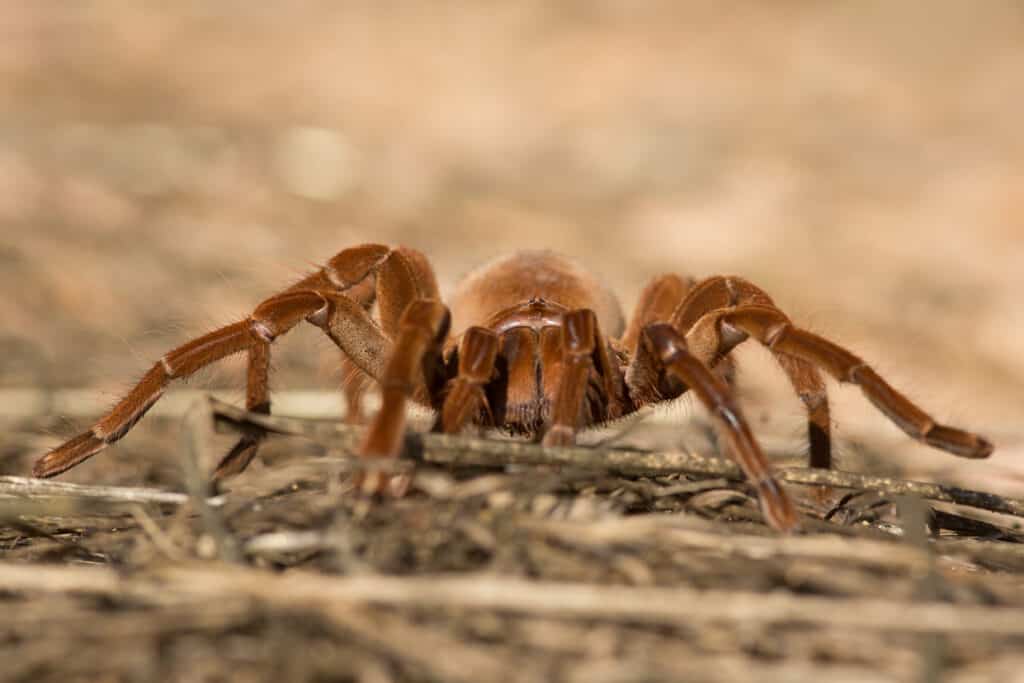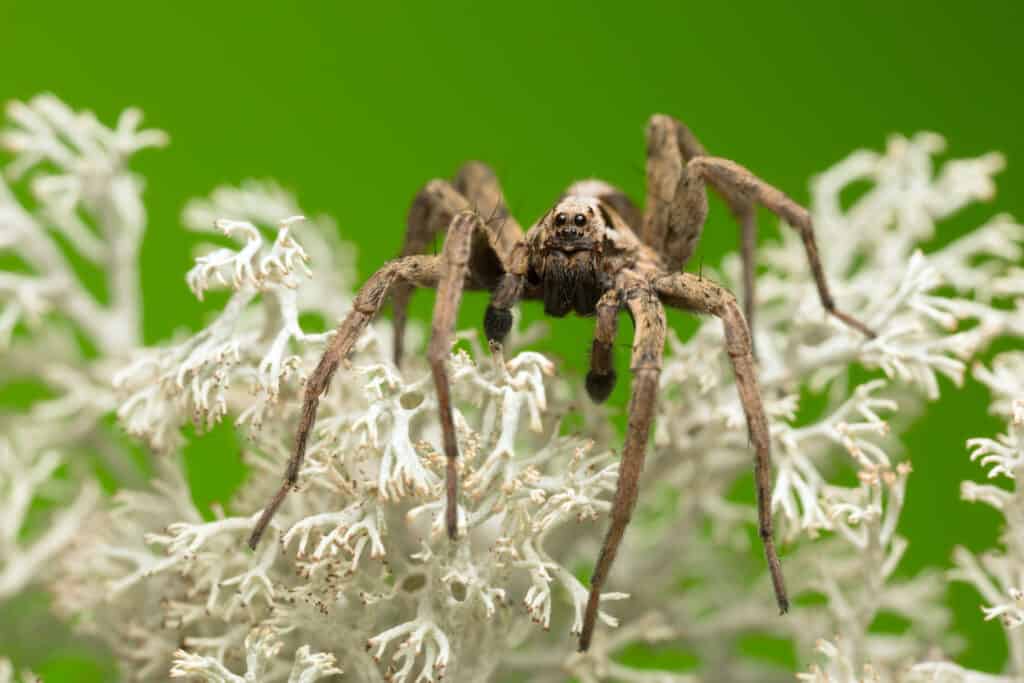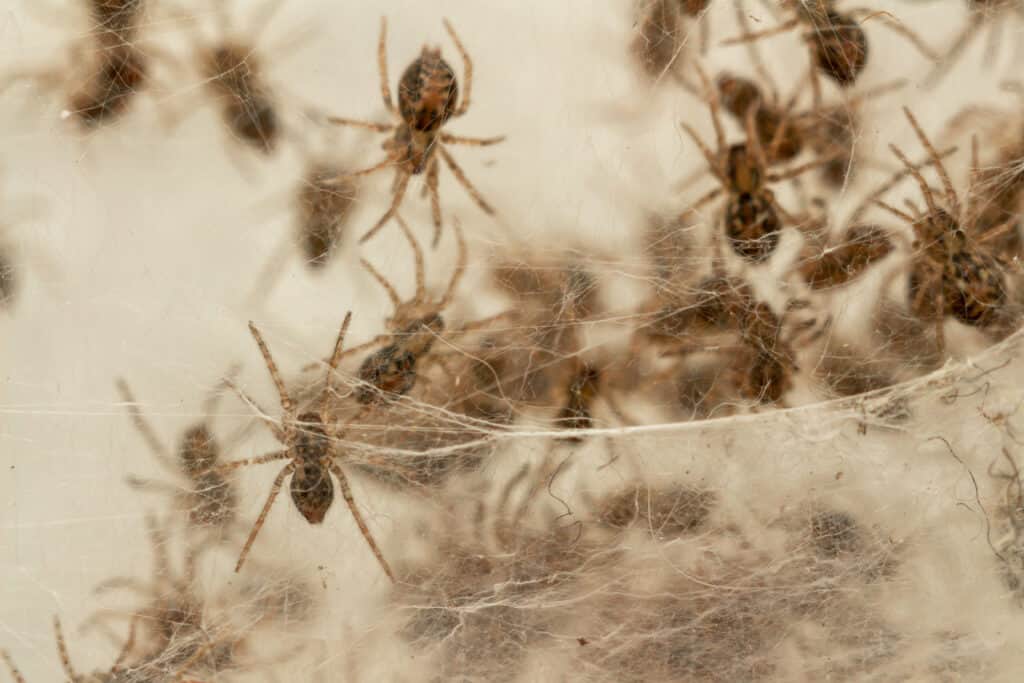Does your knowledge of spiders go beyond the basics? Spiders, for instance, assist in controlling insect populations, which is extremely important for our ecosystem. Some spiders can be quite dangerous as well. A brown recluse spider bite, for example, can trigger fever, chills, dizziness, vomiting, and other symptoms. You may also be surprised to learn that there is one season in particular when spiders tend to be out in full force! This season is known as spider mating season.
So when do spiders breed, and when is their mating season? Find out everything you need to know about that and more!
A Quick Rundown on Spiders

Spiders are not insects but are classified as arachnids because of their eight legs.
©Milan Zygmunt/Shutterstock.com
While many assume that spiders are insects, they are classified as arachnids. This is because arachnids have eight legs, while insects only have six. It is estimated that there are 38,000 species of spiders on all continents except Antarctica. It is believed, however, that there are many more spider species to be discovered. Among the fascinating facts about spiders is the fact that all spiders are able to produce silk, but not all spiders are able to spin webs. As a matter of fact, spider silk can be used for many different things, from making webs to storing eggs.
Spiders play an important role in the ecosystem by consuming large numbers of insects. On rare occasions, one spider may catch hundreds of very small flies in a single day. Silk is used to wrap edible prey so that it can be consumed.
Now, let’s take a closer look at the mating season of spiders now that we’ve learned a little more about them!
When Is Spider Mating Season?

Spider mating season starts at the beginning of autumn.
©Henrik Larsson/Shutterstock.com
As autumn begins to take hold, spider mating season begins. This means these eight-legged creatures will leave their webs in search of a nice dry place to reproduce throughout September and some of October. As a result, you will encounter more spiders during this time.
Every state has spider season in autumn, no matter where you live, whether in Florida, Washington, California, or Maine. In addition, it is not the entire autumn as well. It is only around the beginning of the fall season that spiders start to emerge. As a rule of thumb, that usually happens between September and October each year, as we mentioned. In the middle of autumn, the majority of spiders have already found a partner for the coming season.
Whether you like it or not, spiders are going to visit you once the weather begins to cool. It is important to take steps to eliminate the spider population in your home if you hate this situation.
What Happens During Spider Season?
The spider season brings about a large number of male spiders coming out in order to find a mate. It is interesting to note that females tend to stay indoors or around homes, waiting for males to come to their webs, especially in dark, abandoned areas such as garages and barns. When the mating season is in full swing, it is unlikely you will see female spiders crawling around in your garden. A spider or two may be spotted around the rest of the year. However, they won’t bother you at all. It’s going to be a different story during spider season. It won’t take long to realize how many spiders are crawling around your home.
Is There a Reason Spiders Come Out at the Same Time of Year?
In autumn, spiders all begin mating. Why is that? For this to make sense, you must understand how spiders reproduce. A well-known fact is that female spiders stay in one place throughout their lives. They can feed and shelter themselves thanks to their elaborate webs. It is not uncommon for them to make their homes inside our homes.
Males, on the other hand, are constantly on the move. Mating season is the time when they seek out females to mate with. Your home attracts them, and the females wait for them there. Due to this, you are likely to encounter many males during this period. In addition to spiders, you will also notice so many webs during spider season. During fall, the chances are high that you will walk right into a spider web. In spite of this, it isn’t because spiders are more abundant.
It is rare for male spiders to make webs. Due to their constant travels, they don’t need to build a web and can waste energy doing so. However, creating a mating web is necessary for some species to attract a mate. It’s because of this that they’ll build extra webs around. This is why you’re more likely to fall right into a spider web during the fall season!
When Is Baby Spider Season?

Baby spiders begin to hatch during the spring season.
©Ivan Semenovych/Shutterstock.com
Baby spider season occurs in the spring when spider eggs become spiderlings for a short period. One female spider may produce thousands of eggs in one egg sac at a time. Despite looking like adults, these baby spiders are very small, and you can hardly see them once they have spread out.
On the other hand, those spider eggs that hatch in warm climates will typically do so in the winter months. To prevent them from dying, they stay inside the egg sacs during their development. However, they are still classified as spiderlings even though they aren’t expected to emerge until spring. Despite the cold weather, some spiderlings will emerge earlier than expected and, as a result, die due to the early emergence.
What Happens After Spider Season?

Spiders become inactive during the winter season and stay warm thanks to an anti-freeze chemical they produce.
©spidereyes2020 / flickr – License
After the spider season ends, winter begins, and spiders gradually disappear. The majority of outdoor spiders go inactive but don’t necessarily hibernate. Polyhydroxy is an anti-freeze chemical produced by spiders that prevent them from dying in cold weather. It is possible, however, for indoor spiders to die outside if they go outside.
As for spider eggs, freezing them once they have been laid will likely result in their death. As a precaution against this, eggs that hatch into baby spiders in the winter are kept warm by the egg sacs that they hatch in. Their survival during the winter months depends on a process known as cold hardening after they become adults.
How to Keep Spiders Out of Your House
During spider mating season, you’ll begin to feel as if spiders are everywhere. Since the male spiders are looking for a mate, they’ll begin to look in your home. If you’re keen to keep the eight-legged creatures out of your home, there are a few things you can do.
Some of these steps include:
1. Keep Your Home Clutter-Free
A clean house can keep spiders away since they prefer dark, damp, and cluttered places for shelter. You can prevent the critters from getting into your home by vacuuming and dusting regularly. The use of plastic boxes with lids, rather than cardboard, is ideal for storing things. Due to their love of cardboard boxes, spiders are attracted to them.
2. Make Sure Your House Isn’t Surrounded by Fallen Leaves
It is best not to allow plants to creep too close to your home, as spiders will hide in them.
Don’t let your outdoor space become overrun with dead leaves or wood piles, as these are good spots for spiders to hide. It’s crucial that you maintain your lawn during the early fall season to prevent debris from piling up if you want to keep spiders away.
3. Use Essential Oils in Every Room of Your Home
In the event that strong odors are present near their nests or nooks, spiders will be discouraged from going to these areas. In terms of oils, lavender, eucalyptus, tea tree, citrus, peppermint, and rose are some of the best. Make sure you spray corners, window sills, and baseboards with these oils regularly and replenish them when necessary.
The photo featured at the top of this post is © Vijin Varghese/Shutterstock.com
Thank you for reading! Have some feedback for us? Contact the AZ Animals editorial team.






